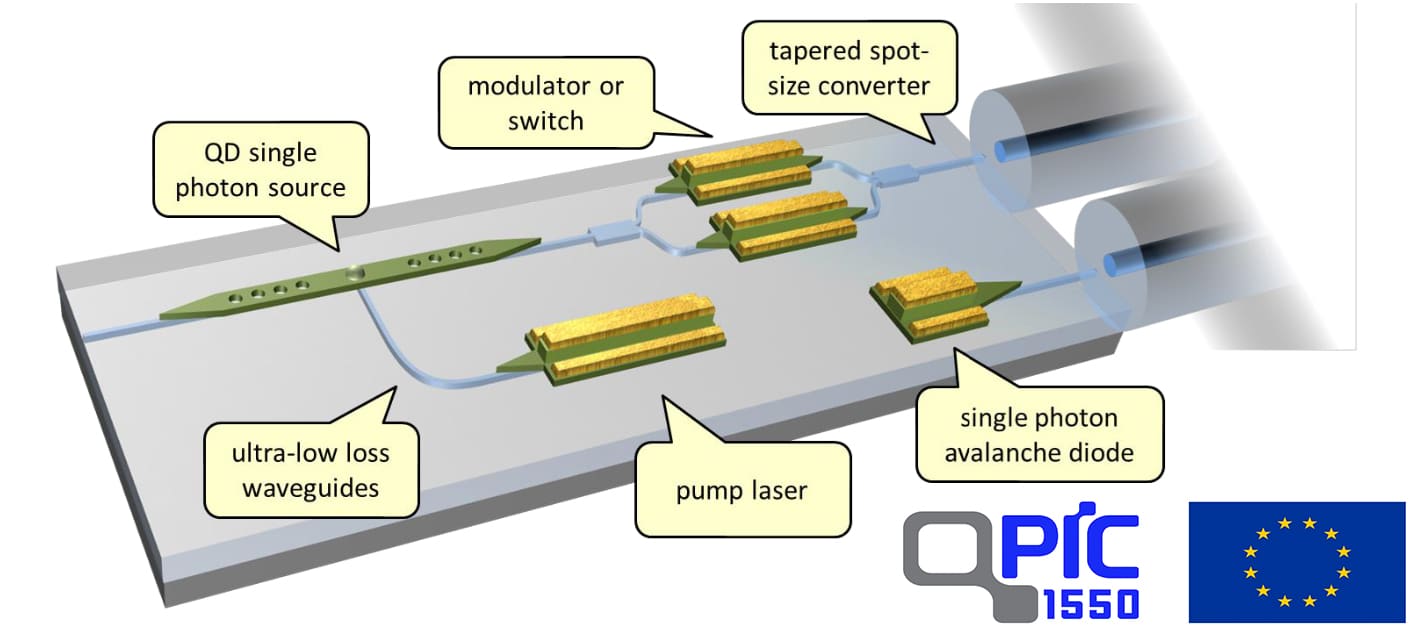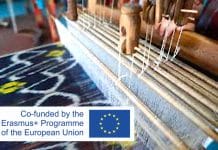 Quantum photonic integrated circuits (QPICs) operating at 1550 nm are becoming increasingly important for the development of quantum technologies due to their ability to provide compact, high-performance, and scalable systems for creation, manipulation and detection of single photons. Single photons are the fundamental building blocks of quantum communications, computing and quantum metrology. In order to realize these quantum technologies, it is crucial to have the ability to manipulate single photons with high precision and reliability. Heterogeneous QPICs offer a promising solution to this challenge by integrating different photonic components such as waveguides, modulators, detectors, and nonlinear materials on a single chip, enabling the creation of complex photonic circuits that can perform a wide range of functions with high efficiency and low loss.
Quantum photonic integrated circuits (QPICs) operating at 1550 nm are becoming increasingly important for the development of quantum technologies due to their ability to provide compact, high-performance, and scalable systems for creation, manipulation and detection of single photons. Single photons are the fundamental building blocks of quantum communications, computing and quantum metrology. In order to realize these quantum technologies, it is crucial to have the ability to manipulate single photons with high precision and reliability. Heterogeneous QPICs offer a promising solution to this challenge by integrating different photonic components such as waveguides, modulators, detectors, and nonlinear materials on a single chip, enabling the creation of complex photonic circuits that can perform a wide range of functions with high efficiency and low loss.
The QPIC1550 research project will undertake the implementation of heterogeneous Quantum Photonic Integrated Circuits (QPICs) operating at 1550 nm, i.e. in the low-loss band of conventional optical communications. It will thus allow their seamless integration into existing infrastructure and scale-up manufacturing processes and make them a cost-effective and practical solution for the development of practical quantum technologies.
Following the success of QPIC1550, the research consortium hopes to be able to use the platforms developed for real-world applications in the field of quantum communication, quantum computing and quantum clock synchronization, with large cost and stability advantages compared to solutions currently in use. As part of the QPIC1550, the world’s first integrated transmitters and receivers will be developed that will be able to demonstrate the quantum concept of non-locality at a distance and thus enable a wide range of computational operations. The QPIC1550 will also seek to co-package such devices, allowing them to be handled and installed by non-expert personnel in order to minimize the time from the lab to the market. Finally, the QPIC1550 will be the first initiative in the world to demonstrate quantum clock synchronization with stability on the order of a few ps (up from tens of ps today), based on quantum photonic integrated devices, which further enhance the practical application of one of the most fundamental functions of the quantum internet.
More specifically, QPICs main objectives include:
- The implementation of InAs/InP quantum dot single photon sources, entangled photon pair sources and Single-Photon Avalanche Diodes integrated with waveguides operating at 1550 nm
- Demonstration of multi-node QPICs in Quantum Key Distribution Experiments and in Remote Quantum Computing at the 1550 nm
- Demonstration of Quantum Clock Synchronization Experiments and Quantum Physical Unclonable Functions (PUFs) based on QPIC1550 devices
The University of West Attica participates with the Parallel and Distributer Systems and Networks Lab (PDSN) and it will contribute to the development and evaluation of a first-generation quantum clock synchronization prototypes, as also to the evaluation of PUFs based on QPIC1550 PICs.
Finally, using the functional prototypes of QPIC1550, UWA aim to develop a two-way quantum clock synchronization system and evaluate it in the PDSN lab using a 50 km fiber spool and on the field, using VODAFONE’s installed fibre network which connects PDSN with the metropolitan network in Athens. Our goal is to build the system in parallel with a classical time dissemination technique already used in different applications from UWA’s lab and compare it with the QPIC1550 system.
Project Title: QPIC-1550 (Quantum photonic integrated circuits at 1550 nm)
Project Duration: 4/12/2023-3/12/2027
Project URL: https://www.qpic1550-project.eu/
Project Framework & Funding: This program has been funded by European Commission with almost 6 million euros in the context of the action: HORIZON-CL4-2023-DIGITAL-EMERGING-01-40 — Quantum Photonic Integrated Circuit technologies (RIA)
Scientific coordinator (UNIWA): Adonis Bogris
Consortium – Partners:
- UNIVERSITY OF WEST ATTICA (Greece)
- TECHNISCHE UNIVERSITEIT EINDHOVEN (Netherlands),
- POLITECNICO DI MILANO (Italy)
- QTI (Italy)
- DANMARKS TEKNISKE UNIVERSITET DTU (Denmark)
- POLITECHNIKA WROCŁAWSKA (Poland)
- LIGENTEC (France)
- MARTEL B.V (France)
- UNIVERSITY COLLEGE CORK (Ireland)
Research Publications / Results / Patents
[1] D. Dermanis, A. Bogris, P. Rizomiliotis, and C. Mesaritakis, “Photonic Physical Unclonable Function based on Integrated Neuromorphic Devices,” J. Light. Technol., 2022,
[2] Bogris, Adonis, Thomas Nikas, and Radan Slavík. “Towards precise one-way fiber-based frequency dissemination using phase-sensitive amplification.” Optics letters 44.3 (2019): 550-553.
[3] Bogris, Adonis, et al. “Sensitive seismic sensors based on microwave frequency fiber interferometry in commercially deployed cables.” Scientific Reports 12.1 (2022): 14000.












